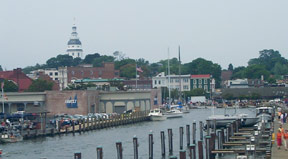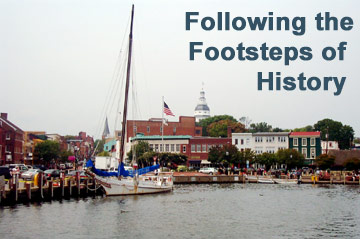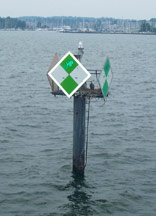 |
|||||||||
|
Volume 12, Issue 35 ~ August 26-September 1, 2004
|
|||||||||
|
Behind Annapolis’ 21st century facade are four centuries’ worth of stories.
by Louis Llovio
On the day Sylvia Lyverly dropped her daughter off for her first day of kindergarten at St. Mary’s School, she saw her city with new eyes. For years on her drives around the historic district, Sylvia had seen costumed docents. But on this day, she took a particular interest. “It looked like a fun thing to do,” she says. So she joined their ranks as a guide with Three Centuries Tours. Today, Lyverly’s daughter is a junior at St. Mary’s, and the woman who confesses to hating history in high school and avoiding it like the plague in college dresses as an 18th century wench, walking tourists through the streets and buildings of Annapolis. In her homemade petticoat, corset and bonnet, Lyverly describes what life was like in the early days of Annapolis. From the bathing habits of townspeople — once a year — to the waste management system of the day — out the window and down the sidewalk — she vitalizes the facts reported in history books. She shows the city from the point of view of a commoner living in a seaport three centuries ago. Lyverly averages one tour a week during the summer months, which is enough, walking as she does clothed in her thick costume that gets scratchy on sticky summer days. Touring picks up in the fall, when she’ll do five tours a week. Once spring hits, tours run non-stop. “I can do up to 10 a week,” she says. In the busiest time of the year, you get to the State House, she says, “and have a thousand people inside. You have to jockey for position and then try to talk over the noise.” The winter months are spent training. Docents meet at least once a week over the colder months of the year, perfecting their craft in lectures by historians, architects and archeologists. Each docent takes a different path through history. “No two tours are ever alike,” Lyverly says. “Each docent has special or favorite stories we’ve picked up along the way that we incorporate into the tour.” Lyverly’s favorite story is how George Washington sneaked a cup of British tea, then an illegal beverage. When a soldier in his command knocked at the door, the great general of the American Revolution hid the cup down his trousers. But the first president of the United States forgot the teacup, stood up and soon developed an un-squire-like stain in the front of his pants. “The kids especially love that story,” she says. “It puts a human face to this grand man of history.” If only, she says, grown-ups knew as much of their city’s history as the kids do. “A lot of people live in Annapolis and don’t pay attention,” says the woman who admits having worn blinders herself. Now she knows the truth, and so can you, if you walk with her. “There are so many interesting stories,” Lyverly says. “Every one of them is an 18th century story brought to the 21st century.”
The unenviable task of trying to explain 355 years of history while maneuvering the labyrinth of Annapolis traffic falls on the shoulders of Matt Grubbs. As Grubbs will tell you, it’s not easy trying to point out the Tiffany window in St. Anne’s Church to a trolley full of Englishmen when the guy in the car behind is 10 minutes late for a meeting and honking. “We try to make sure we don’t impede traffic,” says Grubbs, who patiently moves out of the way so the cars behind him can pass. You wonder if he is so gracious with other drivers when he’s in his own vehicle. Actually, the trolley is his vehicle. The one-year-old air-conditioned trolley smells much like an RV. It’s highlighted with light wood paneling, deep red seat cushions and a dashboard with knobs to rival an airplane. It’s a far cry from the single mini-bus Grubbs and his wife drove their first six years in business. A marketing executive, Grubbs was downsized in the mid-1990s. He returned to his roots to pursue a passion he’d discovered as a high school student, when he led walking tours for Historic Annapolis Foundation. After months of careful market research, he decided Annapolis needed a driving tour. On June 6, 1996, Discover Annapolis gave its first tour. “A lot of people who come to town,” says Grubbs of why he chose to start a driving tour, “like either a quick tour with just the highlights or are looking to get an overview so they can go back on their own by foot.” Discover Annapolis takes you from West Street out to the private historic homes along Spa Creek, around Main Street, down Duke of Gloucester and into Eastport. Then you speed to the overlook above the Severn River, back along the edge of the Naval Academy and around St. John’s College and the historic homes between City Dock and the Academy. The tall, rail-thin former corporate executive leads the tour with a well-practiced wit, his dry and sagacious delivery polished with years of experience. But the well-rehearsed spiel should not be mistaken for indifference. “We travel and get to know the cities we visit,” he says, irritated that locals don’t appreciate local history. “But we ignore the city that we live in. There is so much to see here, and it is so relevant to the history of the United States.” To lure locals aboard his trolley, Grubbs gives free rides to city residents. He learned the marketing ploy on a visit to Williamsburg, where the city hands out passes that get locals into the sites, free. If Grubbs could get you to invest in just one bit of Annapolis history, he says that would be George Washington’s resignation of his commission in 1783, which set the precedent separating the military from the civilian government. “It’s the biggest thing that ever happened to this town,” says Grubbs. Discover Annapolis doesn’t cover that stop on their tour, though. Traffic would line up too far around State Circle.  Speaking in Historic Tones Speaking in Historic TonesTaking a walk through Annapolis is more fun with an experienced guide, especially when it happens to be Walter Cronkite. Hearing him tell the story of Annapolis, you’d think he lived it. Cronkite, who has for years kept a yacht in the area, is a good companion, and for five dollars he is more than happy to spend a couple of hours with you, courtesy of the Historic Annapolis Foundation. A guide can alert you that the familiar house you’re passing is the home where Francis Scott Key was married. A guide can teach you to see the State House with the wise eyes of history. A guide can tell you that the Old Treasury Building is the oldest working public building in the nation. A guide knows that history was written in the homes along the quiet side streets of Annapolis: the William Paca House; the Hammond-Harwood House; Brice House; the Chase Lloyd House and many more. A guide won’t overlook the trivial highlights like Bladden’s folly, named for the former Maryland governor who had to abandon his ambitious home construction when he ran out of money and the legislature refused him any more. The building is now the main building of St. John’s College, previously King William’s School founded in 1696. And without a guide, how can you understand the Naval Academy? From Bancroft Hall to the Navy Chapel, the Academy at one time was the home to one president, 18 members of Congress, four governors, three chairs of the Joint Chiefs of Staff, 50 astronauts and a Nobel Prize winner. The right traveling companion will even tell you that Jimmy Carter, the only U.S. president to graduate from the Academy, spent most of his four years there in trouble for a sloppy dorm room. Through the sights of Annapolis, Cronkite’s smooth-toned voice that for so many years gave us news of the world gives us the history of this capital city. “Isn’t this guy almost 80?” you think, as the voice goes on, never winded. Of course Cronkite’s part of the walk is taped. You didn’t expect the real thing for five dollars, did you? As Seen from the Road As Matt Grubbs admits, Cronkite and costumed interpreters are hard acts to follow. But driving history has rewards of its own. By driving history, you may miss some of the details, but you cover much more in a single trip than by walking. Don’t risk the misadventure of driving Annapolis with a map on the seat next to you. Join a tour like Grubbs’ or bring a passenger to read the map and guidebook. From the historic homes around West Street to the old shipyards in Eastport, you can track the progress of the city through the changing styles in architecture. Historic Annapolis has awarded different-colored markers placed by front doors of homes with historical significance. Each color marker signifies a specific era, and guidebooks give you the story. Escape the downtown traffic by crossing into the Maritime Republic of Eastport, which has seceded from the metropolis across the creek. In the new Maritime Republic, you’ll see shipyards dating back to colonial times. More recently, PT boats for fighting in World War II were built and launched from these docks. To the uninitiated, the restaurants and yacht brokers that now rule the waterfront obscure those historic chapters. Nor could you tell from the homes and condominiums dominating the Republic that Eastport was once the home to both black and white working watermen. Or leave Annapolis along the grounds of the U.S. Naval Academy and cross the Severn River Bridge. Park your car at Annapolis overlook and walk down to the War World II Memorial, which itself offers a commanding view of the city and the water. From this hilltop high above the Severn River, imagine 17th century Puritans gazing down, the Chesapeake to one side, the river running through the other and the wide expanse of farmland along the coast to the south. Today’s view is dominated by the Naval Academy, but you can see the spires of the State House, St. Anne’s Church and St. Mary Church. You see a lot in a little time by driving history, all without having to find a parking space. As Seen by Water By water, you absorb an entirely different perspective of Annapolis. With 26 miles of shoreline, Annapolis has as much to show you in its rivers and creeks as along its sidewalks. Whether you sightsee by sailboat out along the Severn River, by water taxi through one of the many creeks or along the Naval Academy, you’ll see some of the best views from the water. A two-hour tour on the schooner Woodwind sails out along the Severn, slowly skirting the shore with long views of Bay Ridge, the old Navy Shipyards and Debtors Creek, the last so-named for the credit needed to pay for all the big boats and yachts. On a clear day, ships pass to and from Baltimore in the shipping lanes as if they were within easy reach. Even overcast and rainy days provide a whole new view of landmarks like the Bay Bridge. Woodwind, the only sailboat touring Annapolis, runs three times a day from the Annapolis Marriott. Water taxis, on the other hand, will take you anywhere you want, within reason. If you don’t know where you want to go, the captain will lead the way. The least you should do is take a taxi to the other side of the Harbor to see downtown from a sea captain’s point of view. The view of the Carroll House, up Ego Alley and Main Street to the State House and St. Anne’s is a postcard in three dimensions. In addition to the taxi, Water Mark Cruises offers several tours ranging in price, schedule and duration. The 40-minute tour aboard Harbor Queen of the Naval Academy and the Severn River offers views of the school’s athletic fields, where the football and soccer teams practice summer and fall, to the inlet where the midshipmen’s sailboats are moored, out past the all-wood yard patrol boats, where the midshipmen learn seamanship. You’ll travel out to the edge of Greenbury Point. Then back toward the harbor, you pass several buoys, one that in the 1700s would have prevented George Washington from getting grounded on a sandbar. But hit it he did, so he spent the night on a barge waiting for high tide to carry him in. Unlike Washington, your captain will navigate into the Harbor without becoming lodged or stranded. Whether he can run a nation in its infancy remains to be seen.
At the helm, he looks more like an executive in a boardroom than either the schoolteacher he once was or the boat captain he now is. Tall, thin, with close-cropped receding gray hair, Captain Ken Kaye motors the 74-foot, 50,000-pound schooner Woodwind from the docks of Annapolis out into the harbor. He shouts orders to his crew with the easy cadence of an elementary school music teacher, which is what he was for 25 years before being forced into retirement when the music program in his school was shut down. At a a crossroads in life, Kaye chose to set off sailing. He commissioned Woodwind, left his home in Connecticut and moved to Annapolis. For the last 11 years, Captain Kaye, with his daughter Jennifer, has sailed tourists along the shorelines of Annapolis. There is not much talk of history on the Woodwind, but there is much to imagine and much to see. Sailing on the Chesapeake, like walking the close streets of Annapolis, is living history. Long before Baltimore grew into an industrial seaport, Annapolis was Maryland’s main port of call for goods, from tobacco to slaves. The city and its culture have always revolved around the water. Kaye’s schooner Woodwind illustrates the living history of schooners on the Chesapeake. Each year on the Thursday after Columbus Day, Woodwind and 40 other schooners relive that history with the 130-mile Great Chesapeake Schooner Race from Annapolis to Norfolk, Virginia.
Kaye’s tour also includes a lesson in the art of sailing. Forever a teacher, Kaye explains the boat’s every move with the patience learned explaining music theory to fourth graders. He hands over the helm to kids or adults. He allows visitors to raise sails and to help run the schooner. Even with rain falling in sheets, he laughs and makes the best of it, explaining the procedure if the storm takes a turn for the worst. Which has happened. Jokes are a big part of his repertoire, and he is particularly fond of puns. “That’s Green Point,” he shouts over the rustling sails and the chop. “I show you that because I didn’t want this trip to be pointless.” When facing the Naval Academy’s Yard Patrol boats, he explains that their hulls are wooden because they were used as mine patrol boats in World War II. Mines are magnetic, so the wooden hulls protected sailors. “We all know that a mine is a terrible thing to waste,” he adds. His students groan and giggle. “I enjoy the public,” he says. “Seeing kids and adults enjoy the experience makes the teacher in me want to work harder.”  Keep an Eye to the Past Keep an Eye to the PastOne advantage you have over George Washington is that he didn’t spend a lot of time in Annapolis. And the time he did spend here, he was busy fighting a revolution and laying out the groundwork for a new nation. Even if your work keeps you as busy as Washington’s did, as a resident of Chesapeake Country — or even as a visitor — you have the opportunity to see Annapolis one day at a time. Take advantage of that opportunity and see this historic town through new eyes. Be the person who can drive through town and identify the landmarks with just a glance. Become the dinner guest who knows what the colony was originally called and when it became know as Annapolis. Get to know men like William Paca, who helped found not only Annapolis and Maryland but also the nation. Then find out why there are no portraits of his wife. Walk the streets that Washington walked and find the watering holes where he stopped for a drink. Whether you see it by land or by sea, by foot or by car or by boat, don’t let Annapolis’ four centuries of living history pass you by. For when you’re in Annapolis, there’s a story on every street. |
|||||||||
|
© COPYRIGHT 2004 by New Bay Enterprises, Inc. All rights reserved. |

 When George Washington walked the streets of 18th century Annapolis, do you think he paid attention to the cobblestone streets? Did he recognize the history happening around him? Did he wander Annapolis full of wonder over where he found himself?
When George Washington walked the streets of 18th century Annapolis, do you think he paid attention to the cobblestone streets? Did he recognize the history happening around him? Did he wander Annapolis full of wonder over where he found himself?


